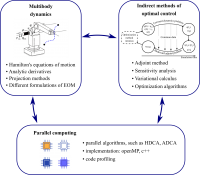Start » Badania » Projekty badawcze »
Hamiltonian approach for large-scale multibody systems
The main objective of this project is to develop and investigate highly efficient methods for computer-aided modeling and analysis of complex multibody systems in a unified Hamiltonian approach
Hamiltonian approach toward efficient modeling of large-scale multibody systems with friction and toward real-time simulations of robotic systems
In the analysis, design, and optimization of numerous mechanical systems, there is a need for automatic modeling and investigation of complex multibody systems with many bodies and degrees of freedom. In this class of systems, multibody modeling methods are widely used in engineering branches and scientific research. The analyzed mechanical or interdisciplinary objects are becoming increasingly complex. The mentioned systems can be frequently found in such areas as robotics (dynamics of manipulators), automotive (testing of car components and complete vehicles), railroad (e.g., traffic safety), defense (e.g., design of tracked vehicles), aerospace (e.g., analysis of unmanned aerial vehicles or their formations). Multibody models are often used in control systems of many mechanical systems, e.g., in robotics. The developed models allow one to predict the behavior of such systems to achieve the desired response. The natural applications of MBS methods also emerge in space and exploratory robotics.
Multibody modeling techniques play a significant and vital role in applications wherein examining phenomena occurring in the existing system is expensive, time-consuming, or very difficult in technical realization. The analysis and simulation of large-scale multibody systems require significant numerical expenses. Simultaneous enforcement of computational efficiency and high-fidelity physical model requirements is sometimes challenging. However, recent studies suggest that using Hamilton’s formalism for the description of multibody system behavior may enhance the performance and significantly increase the efficiency of such computations and, in consequence, may reduce specific barriers associated with real-time applications. In addition, fast calculations with parallel computers, equipped with multi-core processors and GPU card arrays, allow one to analyze systems with much greater complexity—with the number of degrees of freedom approaching tens of thousands (biomolecular systems) or even millions of bodies (granular media). The main objective of this project is to develop and investigate highly efficient methods for computer-aided modeling and analysis of complex multibody systems in a unified Hamiltonian approach. The proposed research focuses on three groups of issues in the field of modeling MBS:
- Research objective 1: Developing efficient sequential and parallel algorithms for modeling MBS in the Hamiltonian framework.
- Research objective 2: Research the methods for analyzing complex multi-rigid- or multi-flexible-body systems with friction.
- Research objective 3: Experimental research on complex robotic systems to the extent necessary for verification of the project’s theoretical considerations and simulation results.



